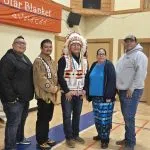
Muskowekwan preserves history for future generations
The last Indian residential school building in Saskatchewan has been designated as a National Historic Site.
“This school stands as a testament to say ‘these things happened, there’s no erasing history if it’s still physically standing’,” said Muskowekwan Chief Cynthia Desjarlais. “Our youth, our future generations, will remember this – and Canada can’t sweep it under the rug.”
On October 3rd, the Muscowequan Indian Residential School was commemorated with two plaques to recognize the designation by Parks Canada and the Monuments Board of Canada.
The brick building was built in 1930-31 to replace the original building which was destroyed by fire.
Although the school finally closed in 1997 –after 108 years of operation – Elders and Survivors wanted the keep the building in tact.
“Our Elders told us, ‘You leave that school standing’ ,” said Desjarlais. “When they were giving away tear down dollars to every school in Canada and were giving out a million or two to those schools, Muskowekwan didn’t take it.”
For more than a century about two dozen Indian Residential School buildings were scattered across the province but most were demolished not long after closing their doors.
Muskowekwan let the community decide the future of the building
“That’s why the school is still standing,” said Desjarlais. “It’s been under the guidance of the Elders to leave it standing. We have to do this for the people and so Canada can’t forget that these places existed.”
The old school is a large, three-story brick building situated on a property that once included a working farm, outbuildings, playgrounds, and skating rinks.
What does the designation mean?
A National Historic site is a place deemed significant to Canadian history.
Parks Canada worked with Indigenous communities and Survivor groups to help share the designation program and identify possible communities. After Muskowekwan expressed interest, the First Nation applied formally, which was then recommended by the Historic Sites and Monuments Board of Canada, and then, approved by the Minister of Canadian Heritage.
“In our program, what we believe is commemoration is not necessarily celebration,” said Dominique Foisy-Geoffroy, Director of History and Commemoration at Parks Canada.. “Commemoration is making sure that things that are important for the development and history of the country are known and shared.”
She said history of the entire Indian Residential School system fits the criteria because it “has had an impact on the Indigenous population and all of Canada.”

The site also holds significance for several findings on unmarked graves.
In 1993, while builders were trenching for water lines, they uncovered between 19 and 22 unmarked graves. Since then, the community has uncovered a total of 53 graves, and continue to investigate the area for additional grave sites.
Chief Desjarlais said many of the graves have been found adjacent to the foundation of buildings.
“We have found them in places you would never think to look for graves,” said Desjarlais, who believes builders from the government may have built over existing graveyards in the 1930s and 40s.
“We want to know what happened, why are there graves in a place like that?” she said.
While the designation as a National Historic Site does not come with any funding for operation or upkeep of the building, Foisy-Geoffroy said the First Nation will be eligible for its cost sharing program, which offers money for costs related to the site.
Desjarlais said, going forward, they want to bring something positive to the building.
The First Nation has been undergoing a restoration of the building and grounds using their own limited funding. Plans for the future of the building could include a historical archive, a training and development centre, a mental wellness space, and an interpretive centre.
“Every residential school was designed to take the Indian out of the child,” said Desjarlais. “Its impacted all of us in very difficult ways, which we’re still battling today. Hopefully this helps us going forward in our healing journey.”


